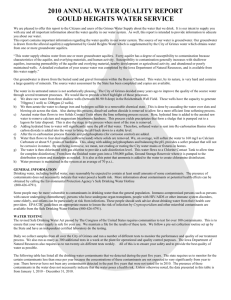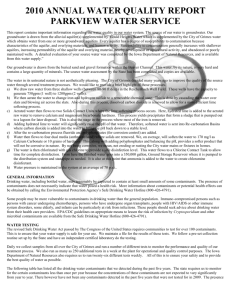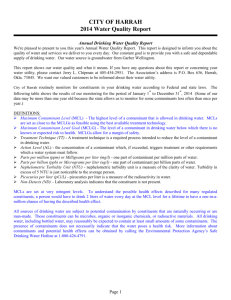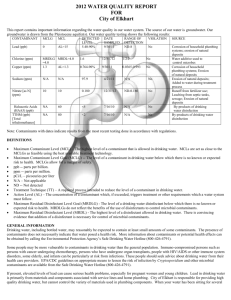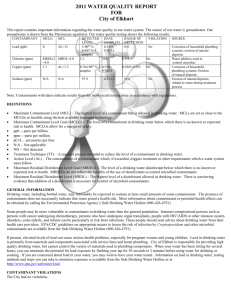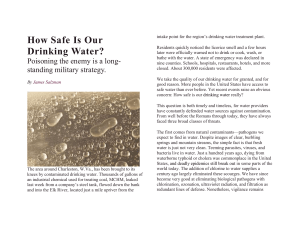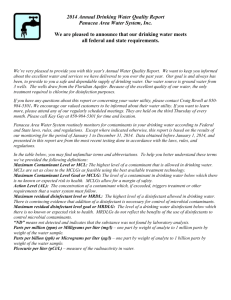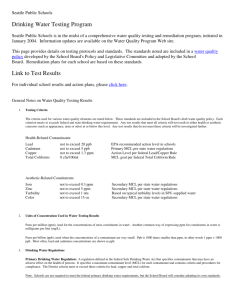2011 Consumer Confidence Report-Gould Heights
advertisement
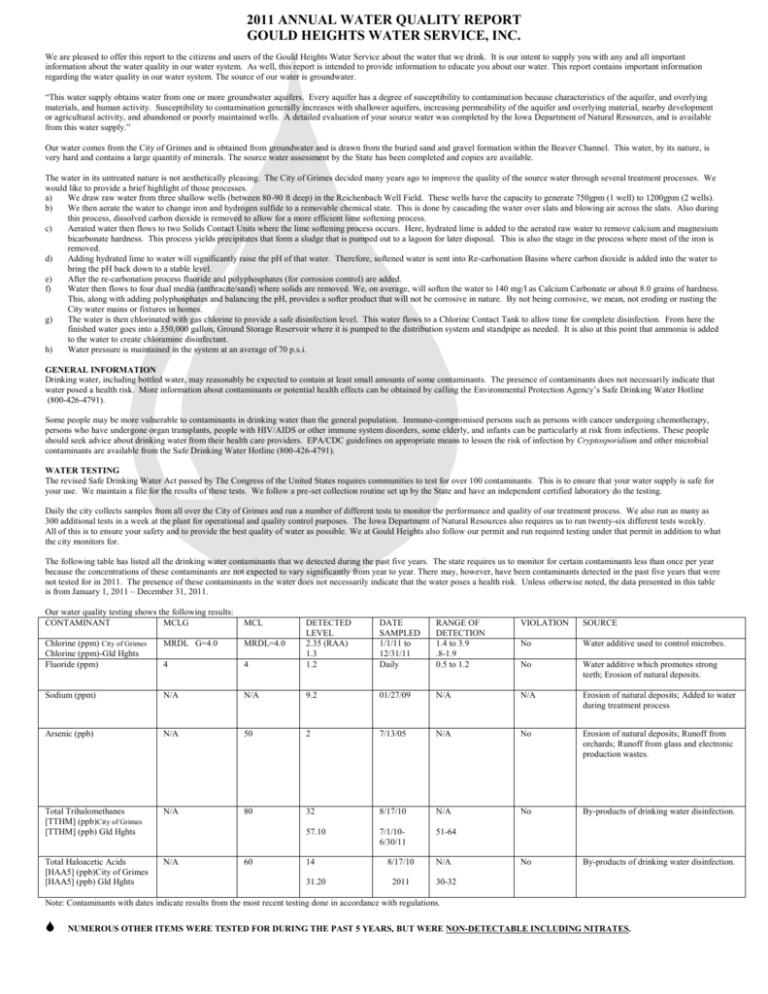
2011 ANNUAL WATER QUALITY REPORT GOULD HEIGHTS WATER SERVICE, INC. We are pleased to offer this report to the citizens and users of the Gould Heights Water Service about the water that we drink. It is our intent to supply you with any and all important information about the water quality in our water system. As well, this report is intended to provide information to educate you about our water. This report contains important information regarding the water quality in our water system. The source of our water is groundwater. “This water supply obtains water from one or more groundwater aquifers. Every aquifer has a degree of susceptibility to contamination because characteristics of the aquifer, and overlying materials, and human activity. Susceptibility to contamination generally increases with shallower aquifers, increasing permeability of the aquifer and overlying material, nearby development or agricultural activity, and abandoned or poorly maintained wells. A detailed evaluation of your source water was completed by the Iowa Department of Natural Resources, and is available from this water supply.” Our water comes from the City of Grimes and is obtained from groundwater and is drawn from the buried sand and gravel formation within the Beaver Channel. This water, by its nature, is very hard and contains a large quantity of minerals. The source water assessment by the State has been completed and copies are available. The water in its untreated nature is not aesthetically pleasing. The City of Grimes decided many years ago to improve the quality of the source water through several treatment processes. We would like to provide a brief highlight of those processes. a) We draw raw water from three shallow wells (between 80-90 ft deep) in the Reichenbach Well Field. These wells have the capacity to generate 750gpm (1 well) to 1200gpm (2 wells). b) We then aerate the water to change iron and hydrogen sulfide to a removable chemical state. This is done by cascading the water over slats and blowing air across the slats. Also during this process, dissolved carbon dioxide is removed to allow for a more efficient lime softening process. c) Aerated water then flows to two Solids Contact Units where the lime softening process occurs. Here, hydrated lime is added to the aerated raw water to remove calcium and magnesium bicarbonate hardness. This process yields precipitates that form a sludge that is pumped out to a lagoon for later disposal. This is also the stage in the process where most of the iron is removed. d) Adding hydrated lime to water will significantly raise the pH of that water. Therefore, softened water is sent into Re-carbonation Basins where carbon dioxide is added into the water to bring the pH back down to a stable level. e) After the re-carbonation process fluoride and polyphosphates (for corrosion control) are added. f) Water then flows to four dual media (anthracite/sand) where solids are removed. We, on average, will soften the water to 140 mg/l as Calcium Carbonate or about 8.0 grains of hardness. This, along with adding polyphosphates and balancing the pH, provides a softer product that will not be corrosive in nature. By not being corrosive, we mean, not eroding or rusting the City water mains or fixtures in homes. g) The water is then chlorinated with gas chlorine to provide a safe disinfection level. This water flows to a Chlorine Contact Tank to allow time for complete disinfection. From here the finished water goes into a 350,000 gallon, Ground Storage Reservoir where it is pumped to the distribution system and standpipe as needed. It is also at this point that ammonia is added to the water to create chloramine disinfectant. h) Water pressure is maintained in the system at an average of 70 p.s.i. GENERAL INFORMATION Drinking water, including bottled water, may reasonably be expected to contain at least small amounts of some contaminants. The presence of contaminants does not necessarily indicate that water posed a health risk. More information about contaminants or potential health effects can be obtained by calling the Environmental Protection Agency’s Safe Drinking Water Hotline (800-426-4791). Some people may be more vulnerable to contaminants in drinking water than the general population. Immuno-compromised persons such as persons with cancer undergoing chemotherapy, persons who have undergone organ transplants, people with HIV/AIDS or other immune system disorders, some elderly, and infants can be particularly at risk from infections. These people should seek advice about drinking water from their health care providers. EPA/CDC guidelines on appropriate means to lessen the risk of infection by Cryptosporidium and other microbial contaminants are available from the Safe Drinking Water Hotline (800-426-4791). WATER TESTING The revised Safe Drinking Water Act passed by The Congress of the United States requires communities to test for over 100 contaminants. This is to ensure that your water supply is safe for your use. We maintain a file for the results of these tests. We follow a pre-set collection routine set up by the State and have an independent certified laboratory do the testing. Daily the city collects samples from all over the City of Grimes and run a number of different tests to monitor the performance and quality of our treatment process. We also run as many as 300 additional tests in a week at the plant for operational and quality control purposes. The Iowa Department of Natural Resources also requires us to run twenty-six different tests weekly. All of this is to ensure your safety and to provide the best quality of water as possible. We at Gould Heights also follow our permit and run required testing under that permit in addition to what the city monitors for. The following table has listed all the drinking water contaminants that we detected during the past five years. The state requires us to monitor for certain contaminants less than once per year because the concentrations of these contaminants are not expected to vary significantly from year to year. There may, however, have been contaminants detected in the past five years that were not tested for in 2011. The presence of these contaminants in the water does not necessarily indicate that the water poses a health risk. Unless otherwise noted, the data presented in this table is from January 1, 2011 – December 31, 2011. Our water quality testing shows the following results: CONTAMINANT MCLG MCL Chlorine (ppm) City of Grimes Chlorine (ppm)-Gld Hghts Fluoride (ppm) MRDL G=4.0 MRDL=4.0 4 4 DETECTED LEVEL 2.35 (RAA) 1.3 1.2 Sodium (ppm) N/A N/A 9.2 01/27/09 N/A N/A Erosion of natural deposits; Added to water during treatment process Arsenic (ppb) N/A 50 2 7/13/05 N/A No Erosion of natural deposits; Runoff from orchards; Runoff from glass and electronic production wastes. Total Trihalomethanes [TTHM] (ppb)City of Grimes [TTHM] (ppb) Gld Hghts N/A 80 32 8/17/10 N/A No By-products of drinking water disinfection. 57.10 7/1/106/30/11 51-64 Total Haloacetic Acids [HAA5] (ppb)City of Grimes [HAA5] (ppb) Gld Hghts N/A No By-products of drinking water disinfection. 60 14 31.20 DATE SAMPLED 1/1/11 to 12/31/11 Daily RANGE OF DETECTION 1.4 to 3.9 .8-1.9 0.5 to 1.2 VIOLATION SOURCE No Water additive used to control microbes. No Water additive which promotes strong teeth; Erosion of natural deposits. 8/17/10 2011 N/A 30-32 Note: Contaminants with dates indicate results from the most recent testing done in accordance with regulations. NUMEROUS OTHER ITEMS WERE TESTED FOR DURING THE PAST 5 YEARS, BUT WERE NON-DETECTABLE INCLUDING NITRATES. DEFINITIONS ppb -- parts per billion. ppm -- parts per million. N/A – Not applicable ND -- Not detected Maximum Contaminant Level (MCL) – The highest level of a contaminant that is allowed in drinking water. MCLs are set as close to the MCLGs as feasible using the best available treatment technology. Maximum Contaminant Level Goal (MCLG) -- The level of a contaminant in drinking water below which there is no known or expected risk to health. MCLGs allow for a margin of safety TOTAL COLIFORM/LEAD AND COPPER REPORT Action Level (AL) – The concentration of a contaminant which, if exceeded, triggers treatment or other requirements which a water system must follow. Running Annual Average (RAA) If present, elevated levels of lead can cause serious health problems, especially for pregnant women and young children. Lead in drinking water is primarily from materials and components associated with service lines and home plumbing. Grimes Water Department is responsible for providing high quality drinking water, but cannot control the variety of materials used in plumbing components. When your water has been sitting for several hours, you can minimize the potential for lead exposure by flushing your tap for 30 seconds to 2 minutes before using water for drinking or cooking. If you are concerned about lead in your water, you may wish to have your water tested. Information on lead in drinking water, testing methods, and steps you can take to minimize exposure is available from the Safe Drinking Water Hotline or at www.epa.gov/safewater/lead VIOLATION TYPE CONTAMINANT BEGIN/END DATE ___________________________________________________________________________________________________________ MCL (TCR), ACUTE FECAL COLIFORM 8/01/2011 TO 08/31/2011 FECAL COLIFORM AND E. COLI ARE BACTERIA WHOSE PRESENCE INDICATES THAT THE WATER MAY BE CONTAMINATED WITH HUMAN OR ANIMAL WASTES. MICROBES IN THESE WASTES CAN CAUSE SHOURT-TERM EFFECTS, SUCH AS DIARRHEA, CRAMPS, NAUSEA, HEADACHES, OR OTHER SYMPTOMS. THEY MAY POSE A SPECIAL HEALTH RISK FOR INFANTS, YOUNG CHILDREN, AND PEOPLE WITH SEVERELY COMPROMISED IMMUNE SYSTEMS. Analyte MCL/AL MCLG Compliance Detect Samples Begin Date End Date Source Type/Value Min/Max Total/ Exceed Fecal Coliform A routine sample 0 TCR NA/NA 2/1 8/1/2011 8/31/11 Human and and E coli and a repeat are animal fecal total coliform waste positive, and one is also fecal coliform or E. Coli positive Total Coliform Presence of 0 TCR NA/NA 12/2 8/1/11 8/31/11 Naturally present Bacteria coliform bacteria in the in >5% of environment monthly samples Copper (ppm) 1.3 1.3 90th -0 0/0.06 20/0 6/1/07 9/30/09 Corrosion of Gould Heights 0.0861-90% ND-0.117 10/0 household plumbing systems; Erosion of natural deposits; Leaching from wood preservatives th Lead (ppb) 15 0 90 - 3 3/7 20/0 6/1/07 9/30/09 Corrosion of Gould Heights 15-90% 0/9 10/0 household plumbing systems; erosion of natural deposits th Lead (ppb) 15 0 95 - 4 4/7 20/0 6/1/07 9/30/09 Corrosion of Gould Heights 9-95% 0/9 10/0 household plumbing systems; erosion of natural deposits MCL (TCR), MONTHLY COLIFORM (TCR) 8/01/2011 TO 08/31/2011 COLIFORMS ARE BACTERIA WHICH ARE NATURALLY PRESENT IN THE ENVIRONMENT AND ARE USED AS AN INDICATOR THAT OTHER POTENTIALLYHARMFUL BACTERIA MAY BE PRESENT. COLIFORMS WERE FOUND IN MORE SAMPLES THAN ALLOWED AND THIS WAS A WARNING OF POTENTIAL PROBLEMS ADDITIONAL HEALTH INFORMATION Infants and young children are typically more vulnerable to lead in drinking water than the general population. It is possible that lead levels at your home may be higher than at other homes in the community as a result of materials used in your home’s plumbing. If you are concerned about elevated lead levels in your home’s water, you may wish to have your water tested and flush your tap for 30 seconds to 2 minutes before using tap water. Additional information is available from the Safe Drinking Water Hotline (800-426-4791). OTHER VIOLATIONS NONE CONTACT INFORMATION For questions regarding this information, please contact Tom Thorpe at 515-289-2345 during the following hours: 8:00 AM to 5:00 PM.

